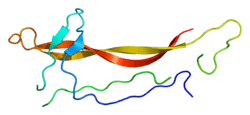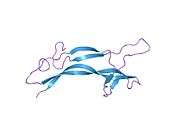Neurotrophin-3
| View/Edit Human | View/Edit Mouse |
Neurotrophin-3 is a protein that in humans is encoded by the NTF3 gene.[3][4]
The protein encoded by this gene, NT-3, is a neurotrophic factor in the NGF (Nerve Growth Factor) family of neurotrophins. It is a protein growth factor which has activity on certain neurons of the peripheral and central nervous system; it helps to support the survival and differentiation of existing neurons, and encourages the growth and differentiation of new neurons and synapses. NT-3 was the third neurotrophic factor to be characterized, after nerve growth factor (NGF) and BDNF (Brain Derived Neurotrophic Factor).[5]
Function
Although the vast majority of neurons in the mammalian brain are formed prenatally, parts of the adult brain retain the ability to grow new neurons from neural stem cells; a process known as neurogenesis. Neurotrophins are chemicals that help to stimulate and control neurogenesis.
NT-3 is unique in the number of neurons it can potentially stimulate, given its ability to activate two of the receptor tyrosine kinase neurotrophin receptors (TrkC and TrkB - see below).
Mice born without the ability to make NT-3 have loss of proprioceptive and subsets of mechanoreceptive sensory neurons.[6][7]
Mechanism of action
NT-3 binds three receptors on the surface of cells which are capable of responding to this growth factor:
- TrkC (pronounced "Track C"), is apparently the "physiologic" receptor, in that it binds with greatest affinity to NT-3.[8][9]
- However, NT-3 is capable of binding and signaling through a TrkC-related receptors called TrkB.
- Finally, NT-3 also binds a second-receptor type besides Trk receptors, called the LNGFR (for "low affinity nerve growth factor receptor).
High affinity receptors
TrkC is a receptor tyrosine kinase (meaning it mediates its actions by causing the addition of phosphate molecules on certain tyrosines in the cell, activating cellular signaling).
As mentioned above, there are other related Trk receptors, TrkA and TrkB. Also as mentioned, there are other neurotrophic factors structurally related to NT-3:
- NGF (for "Nerve Growth Factor")
- BDNF (for "Brain Derived Neurotrophic Factor")
- NT-4 (for "Neurotrophin-4")
While TrkB mediates the effects of BDNF, NT-4, and NT-3, TrkA binds and is activated by NGF, and TrkC binds and is activated only by NT-3.
Low affinity receptors
The other NT-3 receptor, the LNGFR, plays a somewhat less clear role. Some researchers have shown the LNGFR binds and serves as a "sink" for neurotrophins.
The crystal structure of NT-3 shows that NT-3 forms a central homodimer around which two glycosylated p75 LNGFR molecules bind symmetrically. The symmetrical binding takes place along the NT-3 interfaces, resulting in a 2:2 ligand-receptor cluster in the center.[10]
Cells which express both the LNGFR and the Trk receptors might therefore have a greater activity - since they have a higher "microconcentration" of the neurotrophin.
It has also been shown, however, that the LNGFR may signal a cell to die via apoptosis - so therefore cells expressing the LNGFR in the absence of Trk receptors may die rather than live in the presence of a neurotrophin.
References
- ↑ "Human PubMed Reference:".
- ↑ "Mouse PubMed Reference:".
- ↑ Maisonpierre PC, Le Beau MM, Espinosa R III, Ip NY, Belluscio L, de la Monte SM, Squinto S, Furth ME, Yancopoulos GD (Oct 1991). "Human and rat brain-derived neurotrophic factor and neurotrophin-3: gene structures, distributions, and chromosomal localizations". Genomics. 10 (3): 558–68. doi:10.1016/0888-7543(91)90436-I. PMID 1889806.
- ↑ "Entrez Gene: NTF3 neurotrophin 3".
- ↑ Maisonpierre P, Belluscio L, Squinto S, Ip N, Furth M, Lindsay R, Yancopoulos G (1990). "Neurotrophin-3: a neurotrophic factor related to NGF and BDNF". Science. 247 (4949 Pt 1): 1446–51. doi:10.1126/science.2321006. PMID 2321006.
- ↑ Tessarollo L, Vogel K, Palko M, Reid S, Parada L (1994). "Targeted mutation in the neurotrophin-3 gene results in loss of muscle sensory neurons". Proc Natl Acad Sci USA. 91 (25): 11844–8. doi:10.1073/pnas.91.25.11844. PMC 45332
 . PMID 7991545.
. PMID 7991545. - ↑ Klein R, Silos-Santiago I, Smeyne R, Lira S, Brambilla R, Bryant S, Zhang L, Snider W, Barbacid M (1994). "Disruption of the neurotrophin-3 receptor gene trkC eliminates la muscle afferents and results in abnormal movements". Nature. 368 (6468): 249–51. doi:10.1038/368249a0. PMID 8145824.
- ↑ Lamballe F, Klein R, Barbacid M (1991). "trkC, a new member of the trk family of tyrosine protein kinases, is a receptor for neurotrophin-3". Cell. 66 (5): 967–79. doi:10.1016/0092-8674(91)90442-2. PMID 1653651.
- ↑ Tessarollo L, Tsoulfas P, Martin-Zanca D, Gilbert D, Jenkins N, Copeland N, Parada L (1993). "trkC, a receptor for neurotrophin-3, is widely expressed in the developing nervous system and in non-neuronal tissues". Development. 118 (2): 463–75. PMID 8223273.
- ↑ Gong Y, Cao P, Yu HJ, Jiang T (August 2008). "Crystal structure of the neurotrophin-3 and p75NTR symmetrical complex". Nature. 454 (7205): 789–93. doi:10.1038/nature07089. PMID 18596692.
Further reading
- Kalcheim C, Carmeli C, Rosenthal A (1992). "Neurotrophin 3 is a mitogen for cultured neural crest cells.". Proc. Natl. Acad. Sci. U.S.A. 89 (5): 1661–5. doi:10.1073/pnas.89.5.1661. PMC 48512
 . PMID 1542658.
. PMID 1542658. - Ozçelik T, Rosenthal A, Francke U (1991). "Chromosomal mapping of brain-derived neurotrophic factor and neurotrophin-3 genes in man and mouse.". Genomics. 10 (3): 569–75. doi:10.1016/0888-7543(91)90437-J. PMID 1889807.
- Hallböök F, Ibáñez CF, Persson H (1991). "Evolutionary studies of the nerve growth factor family reveal a novel member abundantly expressed in Xenopus ovary.". Neuron. 6 (5): 845–58. doi:10.1016/0896-6273(91)90180-8. PMID 2025430.
- Jones KR, Reichardt LF (1990). "Molecular cloning of a human gene that is a member of the nerve growth factor family.". Proc. Natl. Acad. Sci. U.S.A. 87 (20): 8060–4. doi:10.1073/pnas.87.20.8060. PMC 54892
 . PMID 2236018.
. PMID 2236018. - Rosenthal A, Goeddel DV, Nguyen T, et al. (1990). "Primary structure and biological activity of a novel human neurotrophic factor.". Neuron. 4 (5): 767–73. doi:10.1016/0896-6273(90)90203-R. PMID 2344409.
- Kaisho Y, Yoshimura K, Nakahama K (1990). "Cloning and expression of a cDNA encoding a novel human neurotrophic factor.". FEBS Lett. 266 (1-2): 187–91. doi:10.1016/0014-5793(90)81536-W. PMID 2365067.
- Ernfors P, Lee KF, Kucera J, Jaenisch R (1994). "Lack of neurotrophin-3 leads to deficiencies in the peripheral nervous system and loss of limb proprioceptive afferents.". Cell. 77 (4): 503–12. doi:10.1016/0092-8674(94)90213-5. PMID 7514502.
- Robinson RC, Radziejewski C, Stuart DI, Jones EY (1995). "Structure of the brain-derived neurotrophic factor/neurotrophin 3 heterodimer.". Biochemistry. 34 (13): 4139–46. doi:10.1021/bi00013a001. PMID 7703225.
- Hattori M, Nanko S (1995). "Association of neurotrophin-3 gene variant with severe forms of schizophrenia.". Biochem. Biophys. Res. Commun. 209 (2): 513–8. doi:10.1006/bbrc.1995.1531. PMID 7733919.
- Tessarollo L, Vogel KS, Palko ME, et al. (1995). "Targeted mutation in the neurotrophin-3 gene results in loss of muscle sensory neurons.". Proc. Natl. Acad. Sci. U.S.A. 91 (25): 11844–8. doi:10.1073/pnas.91.25.11844. PMC 45332
 . PMID 7991545.
. PMID 7991545. - Rydén M, Ibáñez CF (1996). "Binding of neurotrophin-3 to p75LNGFR, TrkA, and TrkB mediated by a single functional epitope distinct from that recognized by trkC.". J. Biol. Chem. 271 (10): 5623–7. doi:10.1074/jbc.271.10.5623. PMID 8621424.
- Hui JO, Le J, Katta V, et al. (1996). "Human neurotrophin-3: a one-step peptide mapping method and complete disulfide characterization of the recombinant protein.". J. Protein Chem. 15 (4): 351–8. doi:10.1007/BF01886861. PMID 8819011.
- Donovan MJ, Hahn R, Tessarollo L, Hempstead BL (1996). "Identification of an essential nonneuronal function of neurotrophin 3 in mammalian cardiac development.". Nat. Genet. 14 (2): 210–3. doi:10.1038/ng1096-210. PMID 8841198.
- Arinami T, Takekoshi K, Itokawa M, et al. (1996). "Failure to find associations of the CA repeat polymorphism in the first intron and the Gly-63/Glu-63 polymorphism of the neurotrophin-3 gene with schizophrenia.". Psychiatr. Genet. 6 (1): 13–5. doi:10.1097/00041444-199621000-00003. PMID 8925252.
- Urfer R, Tsoulfas P, O'Connell L, et al. (1998). "High resolution mapping of the binding site of TrkA for nerve growth factor and TrkC for neurotrophin-3 on the second immunoglobulin-like domain of the Trk receptors.". J. Biol. Chem. 273 (10): 5829–40. doi:10.1074/jbc.273.10.5829. PMID 9488719.
- Suenaga M, Ohmae H, Tsuji S, et al. (1998). "Renaturation of recombinant human neurotrophin-3 from inclusion bodies using a suppressor agent of aggregation.". Biotechnol. Appl. Biochem. 28 (2): 119–24. PMID 9756741.
- Hochhaus F, Koehne P, Schäper C, et al. (2003). "Elevated nerve growth factor and neurotrophin-3 levels in cerebrospinal fluid of children with hydrocephalus.". BMC pediatrics. 1: 2. doi:10.1186/1471-2431-1-2. PMC 57003
 . PMID 11580868.
. PMID 11580868. - Kobayashi H, Gleich GJ, Butterfield JH, Kita H (2002). "Human eosinophils produce neurotrophins and secrete nerve growth factor on immunologic stimuli.". Blood. 99 (6): 2214–20. doi:10.1182/blood.V99.6.2214. PMID 11877300.
- Hattori M, Kunugi H, Akahane A, et al. (2002). "Novel polymorphisms in the promoter region of the neurotrophin-3 gene and their associations with schizophrenia.". Am. J. Med. Genet. 114 (3): 304–9. doi:10.1002/ajmg.10248. PMID 11920853.




